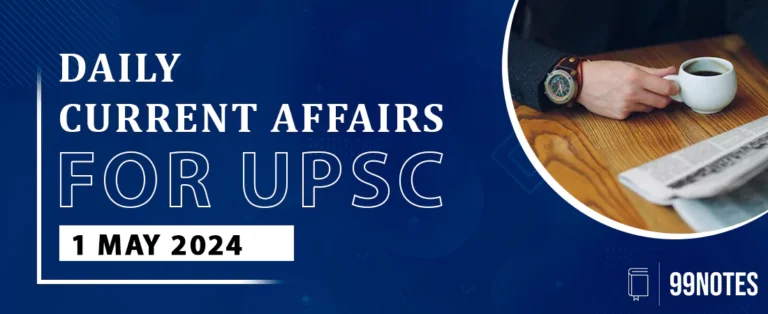8 Feb 2024 : Daily Current Affairs
Daily Current Affairs
8-February-2024- Top News of the Day
1. 390-year-old lamp post in Nalgonda unravels trade links of Telangana
| Topic: GS1 – History – Indian Culture – Architecture UPSC-relevant: Unearthed 390-year-old lamp post in Telangana signifies early medieval riverine trade, offering historical insights for aspirants. |
| Context |
|
Additional information on this news:
- A 390-year-old Deepastambham (lamp post) has been discovered on the edge of River Krishna in Nalgonda district, Telangana, shedding light on early medieval trade ties in the region.
- The pillar, found in Mudimanikyam village, is 20 feet tall with hollows for lamps and features a multi-lingual inscription.
- Ashok Kumar of the Public Research Institute for History, Archaeology & Heritage made the discovery on a slope leading to the river bank.
- Unlike the common Dhwajasthambam (flag pole) in temple architecture, lamp posts are rare in the Deccan region but are common in temples on the west coast, including Goa.
- The pillar is dated to June 1635 based on the inscription, which is written in a mix of Telugu and Tamil languages.
- It is dedicated to Kasi Viswanatha and likely served as a lighthouse on the riverine trade route due to its height.
- The inscription was engraved by Madiraju Narasayya of Yidupulapāti and erected by Polinedu, son of Vali Munulayya. Similar pillars without inscriptions have been found in Tamil Nadu.
- The village is approximately 180 kilometers from Hyderabad, ruled by the Qutb Shahi rulers during that period.
- European travelers, including the French diamond trader Tavernier, reference land trade routes but also allude to riverine trade in the region.
- The archaeologists also discovered an eighth-century inscription recording a grant during the Badami Chalukya rule, indicating the village’s significance as part of a trade route over the millennia.
2. ‘Solar rooftop scheme positive but challenging’
| Topic: GS2 – Governance – Government Policies UPSC-relevant: Rooftop solar challenges and solutions are vital for India’s energy transition, aligning with national goals. |
| Context |
|
Additional information on this news:
- Government’s proposal to boost rooftop solarisation, via Pradhan Mantri Suryoday Yojana, faces challenges discussed at a panel.
- Experts highlight the need for incentives to encourage household adoption of rooftop solar solutions.
- Current subsidized electricity in states may deter consumers from investing in solar power.
- Sumant Sinha, CEO of ReNew Power, emphasises the necessity of proper tariff structures for selling excess solar power to the grid.
- Global potential for rooftop solar, both residential and commercial, requires supportive regulations.
- Adanair Turner from the Energy Transitions Commission advocates for regulations mandating solar panels on new structures like car parks and factories.
- High air pollution, especially in north India, affects the efficiency of solar panels, necessitating significant subsidies for viability.
- Current household rooftop solar installations constitute only a quarter of the total 12 GW rooftop solar installations in India.
- Approximately 6.7 lakh households have rooftop solar installations, falling short of the targeted 1 crore installations envisioned by Prime Minister Narendra Modi.
| Rooftop solar energy in India |
Potential:
Challenges:
Way Forward:
|
| PYQ: India has immense Potential of solar energy though there are regional variations in its development. Elaborate. (250 words/15m) (UPSC CSE (M) GS-1 2020) |
| Practice Question: What are the key challenges hindering the widespread adoption of rooftop solar energy in India? Suggest potential solutions to address these challenges for promoting sustainable and scalable solar installations. (150 words/10 m) |
3. Strike a fine balance, have a just civil code
| Topic: GS2 – Indian Polity – Indian Constitution – Significant Provisions The article discusses the Law Commission’s role in implementing a culturally sensitive Uniform Civil Code in India. |
| Context |
|
- Law Commission’s Role:
- The Law Commission of India has reopened discussions on the Uniform Civil Code (UCC).
- The authors argue that the UCC should focus on eliminating practices inconsistent with the benchmarks set by the Constitution of India.
- Autonomy vs. Authority:
- Personal laws raise the question of personal and religious autonomy versus the state’s authority to reform familial relations.
- Cultural autonomy is argued as a basis for communities to seek internal reforms, as seen in the Special Marriage Act and Indian Succession Act.
- Religious Identity and Personal Laws:
- Currently, various religious groups, including Hindus, Muslims, Jains, Buddhists, Sikhs, Parsis, and Jews, are governed by their own personal laws.
- Religious identity determines the applicable personal law, with examples highlighting nuances in different scenarios.
- Constitutional Perspective:
- The Indian Constitution upholds cultural accommodation through Article 29(1), dedicated to conserving the distinctive culture of all citizens.
- The Constitution favors a mosaic model of multiculturalism, emphasizing unity over uniformity.
- Multiculturalism and Constitutional Approaches:
- India’s multicultural diversity aligns with the Constitution’s integrationist and restricted multicultural approaches.
- The 21st Law Commission favored equality between individuals over uniformity among communities.
- Secularism and Cultural Accommodation:
- Despite being a secular nation, India chose not to adopt the French model of laïcité, allowing public expression of religion.
- Indian society accommodates a wide array of group and ethnic differences without merely tolerating them.
- Protection of Cultural Traditions:
- Group traditions gain significance when they do not infringe on the rights of fellow citizens and contribute to social and national integration.
- Legal protection of personal laws should align with substantive equality and gender justice goals outlined in the Constitution.
- Challenges and the Path Ahead:
- The Law Commission must navigate challenges in overhauling socio-religious-cultural practices while respecting cultural diversity.
- The Commission should eliminate practices not meeting constitutional benchmarks without contributing to reactive culturalism.
- Call for MPL Reform:
- The Muslim Personal Law (MPL) is highlighted as Anglo-Muhammadan law, not entirely divine, and open to reform.
- The authors urge the Muslim clergy to lead MPL reform by identifying discriminatory issues and adopting progressive views.
- Fine Balance and Constitutional Benchmarks:
- Iris Young’s perspective is invoked, emphasizing the need for the Law Commission to strike a fine balance and eliminate practices inconsistent with constitutional benchmarks.
| PYQ: Discuss the possible factors that inhibit India from enacting for its citizens a uniform civil code as provided for in the Directive Principles of State Policy. (200 words/12.5m) (UPSC CSE (M) GS-2 2015) |
| Practice Question: Discuss the significance of a culturally sensitive Uniform Civil Code in India, considering constitutional benchmarks and multicultural diversity.(250 words/15m) |
4. Government Announces Rs 1 Lakh Crore Fund for Deep-Tech Research and Development in Interim Budget Speech
| Topic: GS2 – Governance – Government policies – Interventions for development in various sectors This topic is relevant for both Prelims and Mains in the context of understanding government initiatives related to research and development. |
| Context: |
|
More about the news:
Importance of Deep Tech:
- Deep tech refers to advanced and disruptive technologies with the potential to bring about transformative change.
- These technologies encompass areas such as nanotechnology, biotechnology, artificial intelligence, and quantum technologies, offering solutions to complex global challenges and driving economic growth.
India’s Position and Potential:
- India, with its large pool of skilled manpower and a growing technology culture, is well-positioned to lead in deep tech innovation.
- The country aims to contribute to the development of these technologies, fostering early adoption, indigenous know-how, and self-reliance, thereby reaping associated benefits such as technology exports and entrepreneurship.
Building an Ecosystem:
- The government has initiated various policies and missions to incentivize research and innovation in deep tech areas.
- Efforts include setting up national missions and policy frameworks to create an enabling environment for deep tech startups, with a focus on long-term funding, intellectual property rights, tax incentives, and talent development.
Challenges in Funding and Government’s Strategy:
- Despite the government’s objective to allocate 2% of GDP for R&D, actual expenditure has fallen short, currently standing at around 0.65% of GDP.
- To bridge this gap, the government is emphasizing partnerships with the private sector, as demonstrated by the establishment of the National Research Foundation (NRF) with significant private industry funding.
The Rs 1 Lakh Crore Corpus and Skepticism:
- The Rs 1 lakh crore fund for R&D aims to kickstart funding in the research ecosystem, particularly benefiting startups and private ventures.
- However, skepticism remains within the scientific community regarding the reliance on private sector investment and the effectiveness of government initiatives in infusing funds into research.
Conclusion:
- While the government’s initiatives signal a commitment to boosting R&D in India, challenges such as insufficient public funding, delays in project disbursal, and skepticism regarding private sector participation persist.
- Moving forward, concerted efforts are needed to address these challenges and create a robust ecosystem for deep tech innovation in the country.
| What is the State of India’s Deep Tech Startups? |
|
| PYQ: Atal Innovation Mission is set up under the (2019) (a) Department of Science and Technology (b) Ministry of Labour and Employment (c) NITI Aayog (d) Ministry of Skill Development and Entrepreneurship Ans: (c) |
| Practice Question: Discuss the significance of the Finance Minister’s announcement regarding the unveiling of a Rs 1 Lakh Crore R&D Fund to propel deep-tech innovation in India. (250 words/15 m) |
5. Supreme Court Mandate Spurs Transition to Consultative Process for Appointment of Election Commissioners
| Topic: GS2 – Polity – Constitutional Bodies – Appointment This topic is relevant for both Prelims and Mains in the context of knowing the interpretation of Article 324 of the Constitution regarding the appointment process of Election Commissioners. |
| Context: |
|
More about the news:
Background and Legal Intervention:
- The Supreme Court’s intervention was prompted by several petitions highlighting the need for a fair and transparent system to appoint Election Commissioners.
- In 2018, a two-judge bench referred the matter to a constitution bench, which commenced hearings in 2022.
- The petitioners argued that the existing opaque appointment system compromised the Election Commission’s independence, urging for a consultative process to select Commissioners.
Previous Appointment Procedure and Legal Standoff:
- Previously, Election Commissioners were appointed solely by the Executive, predominantly retired officers of the Indian Administrative Services.
- The government opposed judicial intervention, arguing that the President had the constitutional authority to appoint Commissioners in the absence of a law by Parliament.
- However, the Supreme Court ruled that Parliament should legislate on the appointment process, emphasizing the need for a consultative approach.
Supreme Court’s Ruling and Consultative Process:
- In March 2023, the Supreme Court ruled that the appointment of Election Commissioners should be made by the President based on the advice of a committee consisting of the Prime Minister, Leader of the Opposition (or the leader of the largest opposition party in the absence of a formal Leader of Opposition), and the Chief Justice of India.
- This marked a significant departure from the previous executive-centric appointment process.
Legislative Response and Concerns:
- Following the Supreme Court’s ruling, the government introduced a Bill in Parliament outlining the appointment procedure for Election Commissioners.
- The Bill, passed in December 2023, established a committee comprising the Prime Minister, Leader of Opposition, and a Cabinet Minister nominated by the Prime Minister.
- However, concerns were raised about the composition of the committee potentially undermining the independence of the Election Commission, as the Leader of Opposition could be consistently outvoted by the Prime Minister and the Union minister.
Conclusion:
- The introduction of a consultative process for appointing Election Commissioners marks a significant reform aimed at enhancing the institution’s independence and transparency.
- While the legislative response reflects a step towards complying with the Supreme Court’s ruling, concerns linger regarding the composition of the selection committee and its potential implications on the Election Commission’s autonomy.
| Global Practices in the Appointment of Electoral Body Members |
South African Model:
United Kingdom Approach:
United States Procedure:
|
| PYQ: To enhance the quality of democracy in India the Election Commission of India has proposed electoral reforms in 2016. What are the suggested reforms and how far are they significant to make democracy successful? (250 words/15m) (UPSC CSE (M) GS-2 2017) |
| Practice Question: Evaluate the challenges and opportunities associated with the new appointment procedure of Election Commissioner and suggest measures to ensure the integrity and effectiveness of the Election Commission in upholding democratic principles. (250 words/15 m) |
6. Union Cabinet Approves Rs 4,797 Crore Research Scheme PRITHVI to Boost Earth Sciences Research Momentum
| Topic: GS3 – Science & Technology This topic is relevant for both Prelims and Mains in the context of understanding government initiatives and policies related to research and development, particularly in critical areas like ocean, atmospheric, and polar sciences. |
| Context: |
|
More about the news:
Addressing Climate Change Challenges:
- In the face of global climate change and its detrimental effects, including extreme weather events, rising sea levels, glacier depletion, and intensified cyclones, there is an increasing necessity to enhance understanding of the roles played by the atmosphere, ocean, and Polar Regions.
- PRITHVI aims to address these challenges by consolidating research efforts across different areas under a unified framework, thereby facilitating more efficient allocation of resources and fostering interdisciplinary collaboration.
Integration of Ongoing Research Projects:
- Previously, research in these key areas was conducted under separate sub-heads, necessitating distinct budget allocations.
- However, with the introduction of PRITHVI, these research endeavors will be amalgamated, allowing for greater flexibility in fund utilization.
- In case of underutilization of funds in one research sub-head, resources can be reallocated to support other priority research areas.
Ongoing Research Projects under PRITHVI:
- Several ongoing research initiatives, including:
- Atmosphere and Climate Research-Modelling Observing Systems and Services (ACROSS),
- Ocean Services, Modelling Application,
- Resources and Technology (O-SMART),
- Polar Science and Cryosphere Research (PACER),
- Seismology and Geosciences (SAGE),
- Research, Education, Training, and Outreach (REACHOUT), will now fall under the umbrella of PRITHVI.
- This integration is expected to streamline research efforts and promote synergy among different scientific disciplines.
International Collaboration and Exploration:
- Notably, PRITHVI will facilitate collaboration between Indian scientists and international experts, fostering knowledge exchange and collaborative research endeavors.
- This opens up opportunities for Indian researchers to engage in global scientific initiatives and leverage international expertise to address complex research challenges.
Progress on Deep Ocean Mission:
- Additionally, Minister Rijiju provided updates on the Rs 4,077 crore Deep Ocean Mission launched by MoES in 2021.
- Extensive surveys and explorations conducted in the central Indian Ocean basin have identified potential locations for hydrothermal activities and sulphide mineralization, indicating progress in the mission’s objectives of exploring deep-sea resources and ecosystems.
| Role of the Ministry of Earth Sciences |
| Provision of Critical Services: The Ministry is responsible for delivering crucial services related to weather, climate, ocean and coastal states, hydrology, seismology, and natural hazards. Support in Disaster Management: These services are essential for issuing forecasts and warnings for natural disasters, thereby aiding in disaster preparedness and risk mitigation. |
| Practice Question: Analyze the significance of the PRITHVI research scheme approved by the Union Cabinet for bolstering research momentum in Earth sciences. Discuss the objectives, scope, and potential impact of the scheme, particularly in addressing global challenges like climate change. (250 words/15 m) |
7. India to Advocate Exclusion of Labor and Environmental Issues from WTO Talks Amid Rising Trade Policy Concerns
| Topic: GS2 – International Relations – Important International institutions This topic is relevant for both Prelims and Mains in the context of understanding India’s position on global trade issues and its strategies in multilateral forums like the WTO. |
| Context: |
|
More about the news:
Developed Nations’ Push for Non-Trade Issues:
- International trade experts have highlighted that developed nations are advocating for non-trade issues, under the guise of sustainability, to address their growing trade deficit with developing nations.
- Furthermore, through proposed WTO reforms, developed nations seek fundamental changes in the WTO structure to favor richer countries.
- India remains steadfast in its position that labor and environmental concerns should not be part of WTO discussions, emphasizing that trade barriers should not be erected under the pretext of sustainable development.
India’s Stance and Rationale:
- Indian officials reiterated that labor and environmental issues are not trade-related matters and should be addressed in specialized forums like the United Nations, rather than at the WTO.
- They argue that the purpose of trade is to ensure sustainable development, and erecting protectionist barriers under the guise of sustainability contradicts this goal.
- India emphasizes that while issues like the EU’s Carbon Border Adjustment Mechanism (CBAM) and deforestation laws are significant, they should be addressed bilaterally rather than in WTO ministerial discussions.
Concerns and Implications:
- Officials expressed concerns that measures like the EU’s CBAM and deforestation laws could violate WTO rules and undermine multilaterally negotiated rights and obligations.
- They emphasize the systemic implications of unilateral actions on international law, highlighting the importance of upholding multilateral agreements and negotiations.
- While India acknowledges the importance of addressing environmental concerns, it stresses the need for a balanced approach that respects international trade rules and obligations.
Conclusion:
- India’s stance at the upcoming WTO Ministerial Conference reflects its commitment to safeguarding its trade interests while advocating for fair and balanced negotiations.
- By opposing the inclusion of non-trade issues like labor and environmental concerns, India aims to ensure that trade discussions remain focused on promoting sustainable development and equitable trade practices.
- Bilateral discussions, rather than multilateral forums like the WTO, are deemed more appropriate for addressing specific environmental issues like the EU’s CBAM and deforestation laws.
| PYQ: What are the direct and indirect subsidies provided to farm sector in India? Discuss the issues raised by the World Trade Organization (WTO) in relation to agricultural subsidies. (250 words/15m) (UPSC CSE (M) GS-3 2023) |
| Practice Question: Discuss India’s stance on the inclusion of labor and environmental issues in WTO negotiations amidst the backdrop of rising global trade policy concerns. Evaluate the potential implications of such measures on international trade dynamics and India’s strategy to safeguard its interests in multilateral forums. (250 words/15 m) |
For Enquiry

8 Feb 2024 : Daily Current Affairs

8 February 2024 : PIB Summary for UPSC

8 Feb 2024 : Indian Express Editorial Analysis

8 February 2024 : The Hindu Editorial Notes PDF

Science Reporter Magazine Summary November 2023

Yojana Magazine Summary September 2023

Kurukshetra Magazine Summary: September 2023

7 Feb 2024 : Daily Current Affairs Quiz

7 Feb 2024 : Daily Answer Writing

7 February 2024 : PIB Summary for UPSC
Daily Current Affairs 8 Feb 2024 : Daily Current Affairs Daily Current Affairs
7-February-2024- Top News of the Day
1. Southern California Braces for Impact…
feb 2024 PIB 8 February 2024 : PIB Summary for UPSC PIB Summary for UPSC
8-February -2024
1. Central Government’s Initiatives to Address Cyber Crimes
Topic:…
Indian Express 8 Feb 2024 : Indian Express Editorial Analysis Indian Express Editorial Analysis
8-February-2023
1. State is in the room
Topic: GS2 – Polity – Indian…
Feb 2024 The Hindu 8 February 2024 : The Hindu Editorial Notes PDF The Hindu Editorial
8-February-2024
1. Downloading child pornography is an offence
Topic: GS2 –…
Science Reporter Science Reporter Magazine Summary November 2023 Science Reporter Magazine Summary November 2023
Science Reporter Magazine is published by the Council…
Yojana Summary Yojana Magazine Summary September 2023 Yojana Magazine Summary September 2023
Yojana magazine is monthly magazine published by government of…
Kurukshetra Summary Kurukshetra Magazine Summary: September 2023 Kurukshetra Magazine Sep 2023 Summary
The September 2023 edition of Kurukshetra Magazine focused on the…
Daily Quiz 7 Feb 2024 : Daily Current Affairs Quiz 7 Feb 2024 : Daily Quiz…
mains answer writing 7 Feb 2024 : Daily Answer Writing Mains Answer Writing
7-February-2024
Q1) What are the locational factors for textile industry? Why have…
feb 2024 PIB 7 February 2024 : PIB Summary for UPSC PIB Summary for UPSC
7-February -2024
1. MICRO IRRIGATION
Topic: GS3 – Agriculture – Irrigation…





